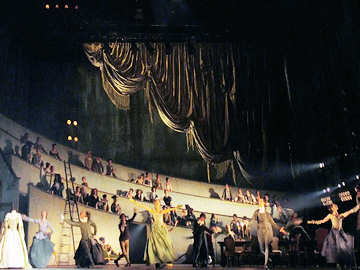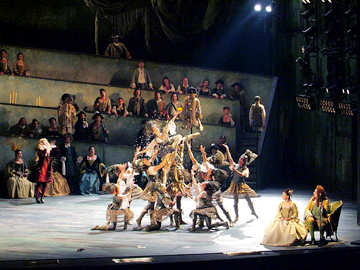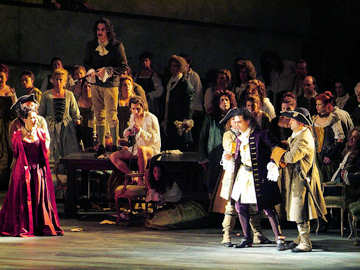|
|
|

Editorial
Board
London Editor:
(London UK)
Melanie
Eskenazi
Regional Editor:
(UK regions and Worldwide)
Bill
Kenny
Webmaster:
Bill
Kenny
Music Web Webmaster:
Len
Mullenger



|
MusicWeb is a
subscription-free site
Clicking Google adverts on our pages helps us keep it that way
Seen
and Heard International Opera Review
Massenet,
Manon:
Soloists, Orchestra and Chorus of The
Gran Teatre del Liceu Conductor:
Victor Pablo Pérez,
Liceu de Barcelona. 27.6.2007 (JMI)
Production:
Director: David McVicar
Sets and Costumes: Tanya McCallin
Lighting: Paule Constable
Cast:
Manon: Natalie Dessay
Des Grieux: Rolando Villazón
Lescaut: Manuel Lanza
Count Des Grieux: Samuel Ramey
Guillot: Francisco Vas
Bretigny: Didier Henry

The core of the 2006/7 opera season at
the Liceu of Barcelona has been Abate
Prevost’s heroine Manon. The saga
started with Puccini’s Manon
Lescaut, followed by Henze’s
Boulevard Solitude
(see review)
and finished
with this Massenet Manon. In
between we also had Massenet's one act
sequel Le Portrait de Manon. So
what could be called the Manon season
reached its end with Massenet's main
work on the subject with an all star
cast, headed by Natalie Dessay and
Rolando Villazón, both of them real
idols for the Barcelona public.
It is peculiar that this subject has
been more popular in Spain than in the
rest of the world through the second
half of the last century. Cities like
Bilbao and Barcelona have seen
sopranos of the stature of Mirella
Freni, Renata Scotto, Victoria De Los
Angeles and Montserrat Caballé,
accompanied by Chevaliers as
outstanding as Alfredo Kraus, Luciano
Pavarotti, Jaime Aragall, Ferruccio
Tagliavini, Alain Vanzo or Giuseppe Di
Stefano. With names like these it is
not difficult to understand the
Manon's popularity in the principal
opera repertoire in Spain. I do not
believe though that any time in the
past was better than recent
performances, but this opera needs
great artists to triumph fully, since
it is served very badly by either
routine or mediocrity.

This production comes from London's
English National Opera with stage
direction by David Mc Vicar, one of
the present day's most interesting
directors. McVicar's production is
spectacular, using a group of
dancers-actors, permanently on stage
but never interefering with the rest
of the action. There is a single set,
consisting of tiers at the back of the
stage, crowned by a large curtain,
producing the effect of a theater
within a theater. Bright, light
coloured costumes add much to the
action, and are particularly
remarkable in the Cours La Reine
scene. Tanya McCallin is responsible
for both the set and costumes and
Paule Constable'a lighting is
outstanding. McVicar's
approach is very good, both in
managing mass movement and in the
direction of the actors: the entrance
of the coach at the station in Act I
is particularly remarkable. The
transitions between scenes are very
good too, allowing the plot to flow
without undesirable pauses. The Act
set in the Hôtel de Transilvanie
becomes “Transexvanie” or
“Transinvanie” in this
production and is full of life. In
summary, this is magnificent work from
a real man of the theater, who has a
perfect knowledge of the score and
great respect for the music. What was
hard understand though is why a
production with only a single set,
needed intermissions lasting for
almost an hour, causing the opera to
finish after midnight. It seems that
the Liceu will start operas half an
hour earlier next season, which seems
a sensible idea.
Musical Direction was in the hands of
Victor Pablo Pérez, whose reading was
good and careful, although it needed
more tension and inspiration to ensure
that the music should maintain its
impetus. Personally, I am not
convinced that including the ballet in
the Cours de la Reine act was a good
idea either, since it broke up the
action and extended the opera
unnecessarily. With a very great group
of dancers this ballet music might be
included, but that was not the case
here, since the actors-dancers used
were not a real ballet company. The
Orchestra Simfònica of the Gran Teatre
del Liceu had a good night, better
than what I have heard from them all
through this season and the Liceu
Chorus was outstanding.

Manon was sung by Natalie
Dessay, who had suffered health
problems in previous performances
because of pharyngitis. Is Manon a
role for a light soprano like hers?
In her debut in Geneva it seemed to me
that her voice sometimes had not
enough weight, particularly in the Saint Sulpice and Transilvanie acts. But
while I keep thinking that Manon needs
more vocal weight, it is clear that
the Barcelona public does not agree. I
recognize that La Dessay is an
absolutely convincing interpreter of
the role, aside from being a great
singer, and I would say she is one of
the best actresses you can see
anywhere today on an opera stage,
even if not absolutely the
best. This fact, together with her
unquestionable quality as a singer,
allows her to triumph in the part,
regardless of questions about vocal
weight. She sang “Adieu, notre petite
table” with distinction and taste, she
shone in the gavota with
spectacular high notes, and at every
opportunity her excellent use of body
language helped to convince and move
the audience. Though she fell a little
short in the first act, she
compensated her lack of vocal weight
with a convincing portrayal in Saint
Sulpice and showed only some poor low
notes only in the Transilvanie scenes.
We were warned about her pharyngitis
but hardly anyone noticed it at all.
Her Manon is clearly more suited to
the theater and DVD than CD though,
especially in a live recording.
Rolando Villazón sang Chevalier Des
Grieux and I am sorry to say that I
have never heard him sing quite so
badly in a theater so I hope this was
just an off night. Even so, he has a
special ability to reach beyond the
footlights and communicate with the
audience, - who adore him and forgive
him anything, at least in Barcelona.
His entrance in Act I left me
perplexed: the voice did not run true
and was smallish and badly projected.
He did sing an outstanding “Dream”
with a beautiful mezza voce of high
quality but his great aria in Saint Sulpice was a big disappointment. He
began this with serious pitch problems
and shortness of breath, which clearly
made him angry with himself. To compensate, he changed style
for the final part of the aria, moving
to the front of the stage to finish as
if it were Puccini’s Manon Lescaut,
extending some notes and opening up
some sounds in a demonstration of very
bad taste. This change of singing
style had pernicious effects on the
audience, who were delirious,
particularly in the gallery. In
Transilvanie Villazón continued with
his more or less verista plan,
avoiding the high note in the
concertante. I think it is fair to
demand more from such a media star.
Sadly some aficionados still come to
the theatre to show their enthusiasm
for an artist, independent of what
they offer on stage and Villazón case
is a clear example of it. The same is
true of Dessay of course, although she
deserves all recognition in this
instance: which certainly did not apply
to the Mexican.
After his Bohème Marcello last
year at the Teatro Real, Madrid,
Manuel Lanza has confirmed that today
he
is a baritone fully recovered from
previous problems and very worthy of
serious consideration as a singer. His
performance as Lescaut was very
convincing.
It is difficult and painful for me to
write about the great Samuel Ramey's
Comte Des Grieux. I have been - and
continue to be - a great admirer of
this artist, without a doubt one of
the more important bass-baritones of
the 80s and 90s and indeed a
reference in so many roles. His
performance in Barcelona made me sad:
the voice retains its volume and the
colour, but he cannot control a huge
and annoying vibrato so that his vocal
instability on stage is spectacular.
He still has all his presence and the
authority, but this is unfortunately
not enough to match his memorable
portrayals of the past.
Francisco Vas though is becoming a
new reference as an interpreter of
secondary parts and his Guillot de
Morfontaine deserves every type of
praise. Didier Henry was not a good
Bretigny as there are better options
in Spain but the three girls (Marisa
Martins and Ana Tobella, Javotte
and Rosette respectively) were all
well characterized and sung, specially
Cristina Obregón as Poussette, There
was nothing of particular interest in
Lluis Sintes' Hôtelier.
A packed house and an audience in
triumph. There was heavy applause for
“En ferment les yeux” and “Fuyez,
fuyez”, in addition to the “Petite
Table”, the Gavota and Saint
Sulpice and enthusiasm exploded at the
end, mostly in the upper floors, for
the two principals, as if we had
attended the Manon of the
millennium. What would Saint Alfredo
Kraus, who is of course in heaven, say about it
though ? Whatever the answer, I suppose
that Rolando Villazón must be asking
himself - like Ford in Falstaff -
“ è sogno or realtá?”
José M Irurzun
José
Maria Irurzun is a former Vice
Chairman of the Friends of Bilbao
Opera Association (ABAO) and Chairman
of the Bilbao Artistic Committee
(Spain.) He was a jury member for the
5th Ottavio Ziino International Opera
Competition in 2006.
Pictures
©
Antoni Bofill
The Liceu de Barcelona web site is
Here
Back
to the Top
Back to the Index Page
|
Seen and Heard, one of the longest established live
music review web sites on the Internet, publishes original reviews
of recitals, concerts and opera performances from the UK and internationally.
We update often, and sometimes daily, to bring you fast reviews,
each of which offers a breadth of knowledge and attention to performance
detail that is sometimes difficult for readers to find elsewhere.
Seen and Heard
publishes interviews with musicians, musicologists and directors
which feature both established artists and lesser known performers.
We also feature articles on the classical music industry and we
use other arts media to connect between music and culture in its
widest terms.
Seen and Heard
aims to present the best in new criticism from writers with a radical
viewpoint and welcomes contributions from all nations. If you would
like to find out more email Regional
Editor Bill Kenny. |
|
| |
|
Contributors: Marc
Bridle, Martin Anderson, Patrick Burnson, Frank Cadenhead, Colin
Clarke, Paul Conway, Geoff Diggines, Sarah Dunlop, Evan Dickerson
Melanie Eskenazi (London Editor) Robert J Farr, Abigail Frymann,
Göran Forsling, Simon Hewitt-Jones, Bruce Hodges,Tim Hodgkinson,
Martin Hoyle, Bernard Jacobson, Tristan Jakob-Hoff, Ben Killeen,
Bill Kenny (Regional Editor), Ian Lace, John Leeman, Sue Loder,Jean
Martin, Neil McGowan, Bettina Mara, Robin Mitchell-Boyask, Simon
Morgan, Aline Nassif, Anne Ozorio, Ian Pace, John Phillips,
Jim Pritchard, John Quinn, Peter Quantrill, Alex Russell, Paul
Serotsky, Harvey Steiman, Christopher Thomas, Raymond Walker, John Warnaby,
Hans-Theodor Wolhfahrt, Peter Grahame Woolf (Founder & Emeritus
Editor)
|
Site design: Bill Kenny
2004 |

